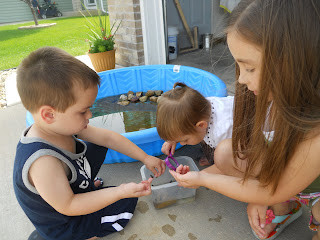So, in the beginning of June, we went on a great tadpole hunt. We rode our bikes around for almost two hours looking in every puddle and creek and riverbed we could find. At the end of the two hours, we were tired, hot, and had no tadpoles to show for all of our searching. We were so discouraged. The kids wanted to keep looking, but Nick and I decided we had better head for home since it looked like it was going to rain. Then, much to our surprise, we found a hundred tadpoles in a drainage puddle only a few blocks from our house. We took our bikes home, and loaded back into our car with all of our tadpole catching equipment. (A net and a few containers.) Then we proceeded to catch about seventy-five of the black, slippery, wiggly little creatures. Here we are hard at work.

The girls were quick to dive into the mud puddle; however, Spencer decided he didn't want to catch any of the tadpoles because his fingers would get dirty! I don't know if he was really adverse to getting dirty, or if he was simply afraid of the tadpoles, but in the end he did decide to join in the fun.

After arriving home, we placed the tadpoles in an old Styrofoam cooler, and set about doing a little research on how to keep them safe, happy, and healthy. We learned that we needed to keep them in natural water--no tap water, we needed to make sure they got some sun and some shade, and we needed to feed them regularly. And what do you feed a tadpole you might ask?
This:

Pond scum and boiled lettuce. And it's very important to feed them too, otherwise they might eat each other. (Learning about their food was also a great time to learn about algae in the water. We put a drop or two of our pond water on a microscope slide and watched all of the paramecium swimming around. The kids thought it was amazing that the tadpoles could feast on something so tiny!)
Everyday for a week we fed the tadpoles and moved them around in the sunlight. Eventually they got big enough that we had to move them out of the cooler and put them into a mini swimming pool. We were sure to get more pond water for the transfer, and this time we put in rocks for the froglets to rest on as they grew up. With their new home and some space to spread out, the tadpoles seemed to shoot out legs overnight. In fact, we thought we would be able to do our official unit on frogs after our National Symbols Unit. As it turned out, however, we had to take a week off of National Symbols to study about frogs and have a frog-freeing expedition. To say the kids loved raising tadpoles would be a massive understatement! They had so much fun, and were so sad the day we had to let our frogs go, that I think we will be raising frogs again next year too. And maybe every year after that.
Here are some pictures of the day we had our frog-freeing expedition.

Emma loved to "check-on" our tadpoles more than anyone else. And by "check-on" I mean poke, scatter, and hold the little guys! She especially loved it when they turned into froglets and could hop out of her hand.



Out of the seventy-five tadpoles that we originally caught, we had 31 to free on our frog-freeing expedition. I'm guessing some had already jumped out of our swimming pool, and the rest were still too little to free so we simply let them continue to grow up and hop out when they were ready. (We did have two little tadpoles pass onto the other side. One that Emma dropped in the grass that we simply could not find--she was so devastated she had killed one, and one that we found dead in the water. Since it wasn't being eaten by the other tadpoles, we assume that they had enough to eat and none of the others were exposed to a cruel and cannibalistic death.) Here are the 31 lucky little froggies! And they truly are lucky. As we read in some of our books, most tadpoles don't make it to become frogs. They are eaten by fish, bugs, etc. or lose their water source and dry out.

And here are my sad children saying good-bye to their baby frogs.


No comments:
Post a Comment